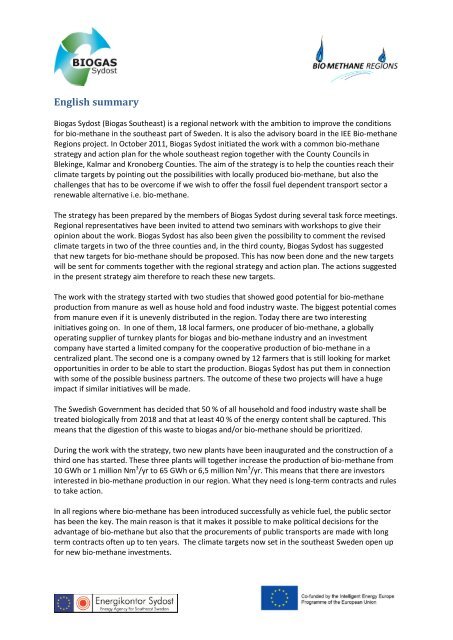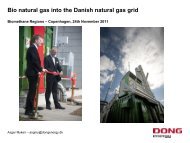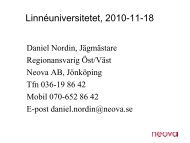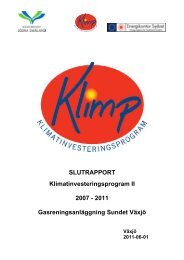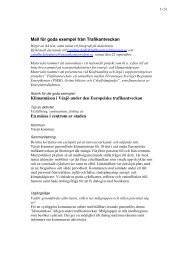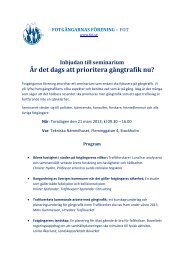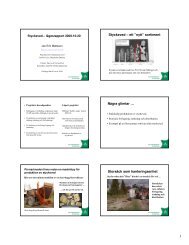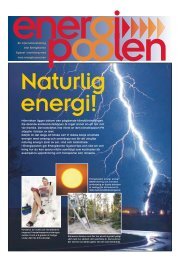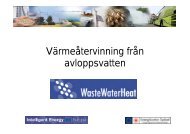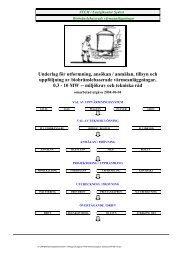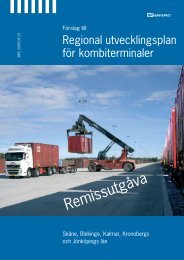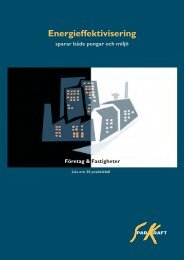Regional strategi för biogas i Sydost Remissupplaga - Energikontor ...
Regional strategi för biogas i Sydost Remissupplaga - Energikontor ...
Regional strategi för biogas i Sydost Remissupplaga - Energikontor ...
Create successful ePaper yourself
Turn your PDF publications into a flip-book with our unique Google optimized e-Paper software.
English summaryBiogas <strong>Sydost</strong> (Biogas Southeast) is a regional network with the ambition to improve the conditionsfor bio-methane in the southeast part of Sweden. It is also the advisory board in the IEE Bio-methaneRegions project. In October 2011, Biogas <strong>Sydost</strong> initiated the work with a common bio-methanestrategy and action plan for the whole southeast region together with the County Councils inBlekinge, Kalmar and Kronoberg Counties. The aim of the strategy is to help the counties reach theirclimate targets by pointing out the possibilities with locally produced bio-methane, but also thechallenges that has to be overcome if we wish to offer the fossil fuel dependent transport sector arenewable alternative i.e. bio-methane.The strategy has been prepared by the members of Biogas <strong>Sydost</strong> during several task force meetings.<strong>Regional</strong> representatives have been invited to attend two seminars with workshops to give theiropinion about the work. Biogas <strong>Sydost</strong> has also been given the possibility to comment the revisedclimate targets in two of the three counties and, in the third county, Biogas <strong>Sydost</strong> has suggestedthat new targets for bio-methane should be proposed. This has now been done and the new targetswill be sent for comments together with the regional strategy and action plan. The actions suggestedin the present strategy aim therefore to reach these new targets.The work with the strategy started with two studies that showed good potential for bio-methaneproduction from manure as well as house hold and food industry waste. The biggest potential comesfrom manure even if it is unevenly distributed in the region. Today there are two interestinginitiatives going on. In one of them, 18 local farmers, one producer of bio-methane, a globallyoperating supplier of turnkey plants for <strong>biogas</strong> and bio-methane industry and an investmentcompany have started a limited company for the cooperative production of bio-methane in acentralized plant. The second one is a company owned by 12 farmers that is still looking for marketopportunities in order to be able to start the production. Biogas <strong>Sydost</strong> has put them in connectionwith some of the possible business partners. The outcome of these two projects will have a hugeimpact if similar initiatives will be made.The Swedish Government has decided that 50 % of all household and food industry waste shall betreated biologically from 2018 and that at least 40 % of the energy content shall be captured. Thismeans that the digestion of this waste to <strong>biogas</strong> and/or bio-methane should be prioritized.During the work with the strategy, two new plants have been inaugurated and the construction of athird one has started. These three plants will together increase the production of bio-methane from10 GWh or 1 million Nm 3 /yr to 65 GWh or 6,5 million Nm 3 /yr. This means that there are investorsinterested in bio-methane production in our region. What they need is long-term contracts and rulesto take action.In all regions where bio-methane has been introduced successfully as vehicle fuel, the public sectorhas been the key. The main reason is that it makes it possible to make political decisions for theadvantage of bio-methane but also that the procurements of public transports are made with longterm contracts often up to ten years. The climate targets now set in the southeast Sweden open upfor new bio-methane investments.


